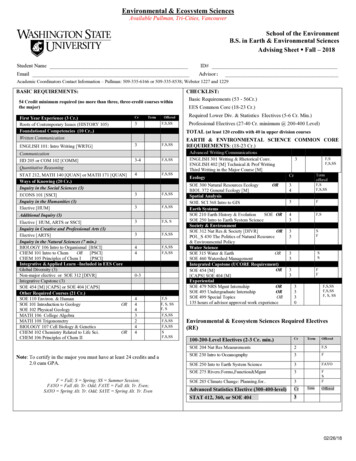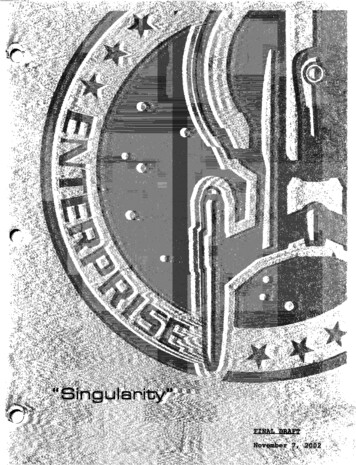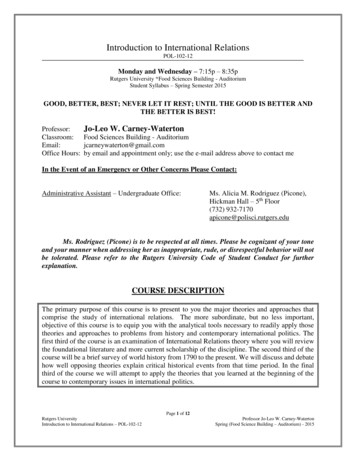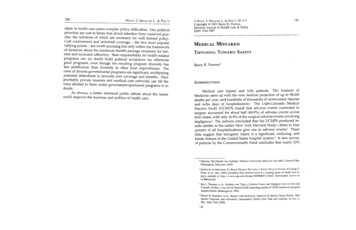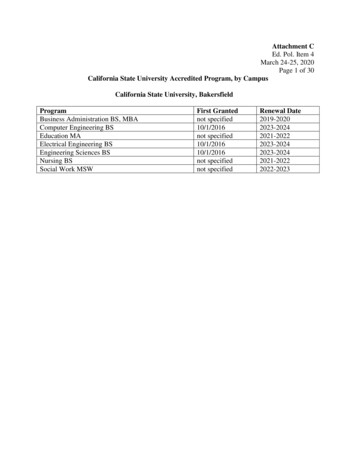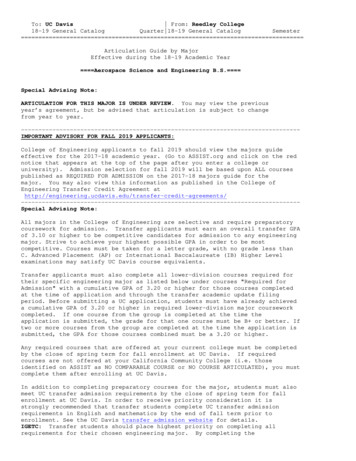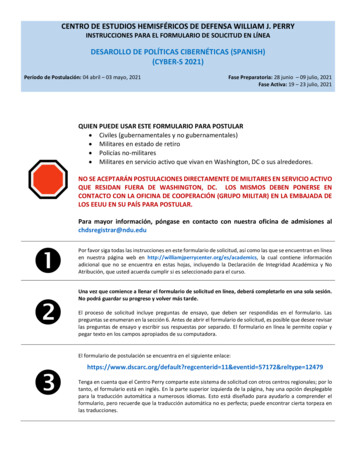
Transcription
CENTRO DE ESTUDIOS HEMISFÉRICOS DE DEFENSA WILLIAM J. PERRYINSTRUCCIONES PARA EL FORMULARIO DE SOLICITUD EN LÍNEADESAROLLO DE POLÍTICAS CIBERNÉTICAS (SPANISH)(CYBER-S 2021)Período de Postulación: 04 abril – 03 mayo, 2021 Fase Preparatoria: 28 junio – 09 julio, 2021Fase Activa: 19 – 23 julio, 2021QUIEN PUEDE USAR ESTE FORMULARIO PARA POSTULAR Civiles (gubernamentales y no gubernamentales) Militares en estado de retiro Policías no-militares Militares en servicio activo que vivan en Washington, DC o sus alrededores.NO SE ACEPTARÁN POSTULACIONES DIRECTAMENTE DE MILITARES EN SERVICIO ACTIVOQUE RESIDAN FUERA DE WASHINGTON, DC. LOS MISMOS DEBEN PONERSE ENCONTACTO CON LA OFICINA DE COOPERACIÓN (GRUPO MILITAR) EN LA EMBAJADA DELOS EEUU EN SU PAÍS PARA POSTULAR.Para mayor información, póngase en contacto con nuestra oficina de admisiones alchdsregistrar@ndu.edu Por favor siga todas las instrucciones en este formulario de solicitud, así como las que se encuentran en líneaen nuestra página web en http://williamjperrycenter.org/es/academics, la cual contiene informaciónadicional que no se encuentra en estas hojas, incluyendo la Declaración de Integridad Académica y NoAtribución, que usted acuerda cumplir si es seleccionado para el curso.Una vez que comience a llenar el formulario de solicitud en línea, deberá completarlo en una sola sesión.No podrá guardar su progreso y volver más tarde.El proceso de solicitud incluye preguntas de ensayo, que deben ser respondidas en el formulario. Laspreguntas se enumeran en la sección 6. Antes de abrir el formulario de solicitud, es posible que desee revisarlas preguntas de ensayo y escribir sus respuestas por separado. El formulario en línea le permite copiar ypegar texto en los campos apropiados de su computadora.El formulario de postulación se encuentra en el siguiente enlace: https://www.dscarc.org/default?regcenterid 11&eventid 57172&reltype 12479Tenga en cuenta que el Centro Perry comparte este sistema de solicitud con otros centros regionales; por lotanto, el formulario está en inglés. En la parte superior izquierda de la página, hay una opción desplegablepara la traducción automática a numerosos idiomas. Esto está diseñado para ayudarlo a comprender elformulario, pero recuerde que la traducción automática no es perfecta; puede encontrar cierta torpeza enlas traducciones.
Después de completar el formulario de solicitud en línea y recibir su número de confirmación, envíe eldocumento siguiente a chdsregistrar@ndu.edu: Formulario de Experiencia Profesional (disponible para descargar en la página de descripción del curso)Cuando envíe sus documentos por correo electrónico el encabezado debe de contener su apellido, país,curso, y el código de confirmación proporcionado por el sistema. No proporcionar esta información con sudocumentación puede ocasionar demoras en el procesamiento de su solicitud.Ejemplo: GÓMEZ – PERÚ – CYBER-S 2021 – QPLFHNJ1234Asegúrese de que el tamaño total de sus archivos adjuntos no exceda los 8 MB. No se otorgarán extensionesa la fecha límite debido a mensajes rechazados por nuestro servidor de correo electrónico.Las solicitudes no se considerarán completas hasta que el Centro Perry reciba todos los documentosrequeridos (formulario de postulación, formulario de experiencia profesional) Al enviar una solicitud, usted certifica que: Ha leído la descripción general del curso, el perfil del candidato y las instrucciones de la aplicaciónen este documento y la página web. Comprende estas instrucciones y acepta cumplir con la Política de Integridad Académica de laUniversidad Nacional de Defensa. Comprende que todos los cursos están sujetos a la disponibilidad de fondos. Cumple con los requisitos de idioma de este curso y (si seleccionado o puesto en la lista de espera)tomará un examen de lectura en inglés (si se le solicita). Toda la información que proporciona es precisa.Todos los postulantes recibirán una notificación por correo electrónico aproximadamente diez semanasantes del inicio del curso, ya sea que 1) hayan sido seleccionados como participantes, 2) hayan sidoseleccionados para la lista de espera o 3) no hayan sido seleccionados. PREGUNTAS DE ENSAYO1.Describa en detalle sus deberes y actividades laborales actuales en relación con la ciberseguridad anivel político y estratégico. (200 palabras máx)2.Describa la misión de su organización (a nivel de política/estrategia) en relación con laciberseguridad y/o defensa. (200 palabras máx)3.Describa cómo este curso lo ayudará personalmente (ahora o en el futuro), o su organización, adesarrollar una política (y/o estrategia) para la seguridad cibernética. (200 palabras máx)4.Después de leer el artículo adjunto, ¿cuál es su opinión sobre su aplicación a nivel de políticas yestrategias? (200 palabras máx)
Evolution of US Cybersecurity StrategySaltuk Karahan1, Hongyi Wu2 and Leigh Armistead31Department of Political Science and Geography, Old Dominion University, Norfolk, USA2Department of Electrical and Computer Engineering, Old Dominion University, Norfolk,USA3Peregrine Technical Solutions, LLC, mAbstract: This paper explores the evolution of the overall Cybersecurity Strategy of the United States, analyzing the changein focus as well as effects of events and technology in this change. It examines the National Security Strategy documents andhow cybersecurity is handled in these documents, making further analysis of specific cybersecurity documents by severaldepartments in the U.S. administration within the last decade. From this research, it was determined that the overallcybersecurity strategy is shaped by involvement of several stakeholders along with security perspectives of differentadministrations, thereof how cybersecurity strategies have changed, and are reflected in the cybersecurity strategies of thedifferent departments and agencies. Specifically three factors with their relevant influence in the evolution of approach tonational cybersecurity strategy are further analyzed with their respective influences, to include (1) international relationswithin the framework of global security, (2) specific incidents of cybersecurity in this period and (3) innovation andtechnology. While each of these factors had an effect in the shaping of the overall U.S. Cybersecurity Strategy documents,the focus of analysis is on “to what extent each of these factors was reflected in the strategy documents and the scope oftheir influence” is of utmost importance. It is our opinion that an analysis of the focus shift and the reflection of theprominent factors into the strategy documents will benefit shaping new strategy documents as well as raising awarenessabout the mindset behind these documents. The findings of this study indicate an increasing influence of global securityenvironment and innovative approaches in strategy documents, as a consequence of comprehensive perspective andincreasing level of expertise in cybersecurity.Keywords: cybersecurity, strategy, national security, U.S. security strategy1. IntroductionAs the discipline of cybersecurity evolves by time, so do the strategies developed by specific agencies ordepartments within nations (Tatar et.al. 2014). We have evaluated a number of U.S. strategy documents withinthe last ten years, have focused in how these documents changed by determining and qualitatively analyzingthe factors behind these changes. Using a content analysis methodology, this paper first determined the threefactors predominantly influencing the change in strategy, to include (1) international relations within theframework of global security, (2) specific incidents of cybersecurity in this period and (3) innovation andtechnology. Overall this paper is organized in five sections, with the introduction stating the rationale for theresearch, methodology and the organization of the paper. In the second section, ten different documents in fivegroups within the last 10 years from several agencies are described in the way they approached to cybersecurityalong with their commonalities with and differences from other strategy documents. The third section outlinesthe main factors influencing the change in strategy and describes how each factor’s influence is seen in thedocuments. The fourth section analyzes these factors with their relative influence, makes comparisons andpresents the findings on their level of influence. Finally, the last section draws conclusions from the findings andproposes a research agenda on the study of national cybersecurity strategy.2. BackgroundWe have analyzed the recent cybersecurity strategy documents in 5 main groups. The first group is comprisedof National Security Documents which included parts about cybersecurity strategy. The second and third groupinclude department level cybersecurity strategy documents (DoD and DHS respectively). The fourth groupincludes the two presidential cybersecurity strategy documents and the fifth group is the Presidential executiveorders related to cybersecurity.2.1 Recent documents of cybersecurity strategy in the U.S.1)U.S. National Security Strategies (2010,2015,2017): Although National Security Strategies are not solelyfocused on cybersecurity, all National Security Strategy documents within the last 10 years specified the168
Saltuk Karahan, Hongyi Wu and Leigh Armisteadcriticality of cybersecurity in National Security. Two of the National Security Strategy (NSS) documents withinthe last 10 years were those signed by President Obama and the last one is the one signed by President Trump.Apart from the overview and conclusion, 2010 NSS lists two sections of “Strategic Approach” and “Advancingour Interests”. Under the section “Advancing Our Interests”, subsections of Security, Prosperity, Values andInternational Order are listed. Under the title of “Secure Cyberspace”, almost a full page of the 10-page longsecurity subsection lists two main action items as Investing in People and Technology, StrengtheningPartnerships. In the subsection of “Prosperity”, cybersecurity is mentioned with respect to cybercrime, globalcommons and Asian allies.In 2015 NSS, very similar to the 2010 NSS, Security, Prosperity, Values and International Order are the mainsections. Strategic Approach is defined in the introduction. A larger portion is dedicated to Cybersecurity withregard to Assuring Access to Shared Spaces (global commons argument). A commitment to assist other countriesto develop laws that enable strong action and the requirement for long-standing norms of international behavioris mentioned. Unlike the document in 2010, there is country specific cyber threat definition in the 2015document. In the section “Advancing Our Rebalance to Asia and the Pacific”, China is mentioned with cybertheft.The 2017 NSS was prepared by an administration having a different view on national security and was comprisedof four pillars and a strategy on regional context. The four pillars are: (1) Protect the American People, the Homeland, and the American Way of Life, (2) Promote American Prosperity, (3) Preserve Peace through Strength, (4) Advance American Influence.As in the previous two NSS documents, under Pillar I (Protect the American People, the Homeland, and theAmerican Way of Life) which is focused on Security, one and a half page is dedicated to Cybersecurity under thesection “Keep America Safe in the Cyber Era”. This latest NSS lists priority actions as (1) Identify and Prioritize Risk, (2) Build Defensible Government Networks, (3) Deter and Disrupt Malicious Cyber Actors, (4) Improve Information Sharing and Sensing, (5) Deploy Layered Defenses.In addition to the coverage of cybersecurity in Pillar I, Pillar II (Preserve Peace through Strength) also dedicatesa subsection to Cyberspace under the section Capabilities. The use of cyberspace by malicious state and nonstate actors for “extortion, information warfare and disinformation” is mentioned along with the capability ofthese attacks in “undermining faith and confidence in democratic institutions and the global economic system”.Furthermore, similar to the nations like Russia and China who approach cybersecurity in the broader context ofinformation warfare, under the section “Diplomacy and Statecraft”, a sub-section is dedicated to “InformationStatecraft” focusing on the use of cyberspace in diplomacy and statecraft.2) U.S. Department of Defense (DoD) Cyber Strategies (2011,2015): At the forefront of Cyber War, DoD has beenone of the main actors – if not the main actor – in shaping U.S. Cybersecurity Strategy. The two documentsanalyzed for this paper were “Department of Defense Strategy for Operating in Cyberspace (July 2011) and “TheDepartment of Defense Cyber Strategy (April 2015)”.Department of Defense Strategy for Operating in Cyberspace (July 2011) lists five strategic initiatives for defensein cyberspace: (1) Treat cyberspace as an operational domain to organize, train, and equip so that DoD can take fulladvantage of cyberspace’s potential,169
Saltuk Karahan, Hongyi Wu and Leigh Armistead (2) Employ new defense operating concepts to protect DoD networks and systems, (3) Partner with other U.S. government departments and agencies and the private sector to enable a wholeof-government cybersecurity strategy, (4) Build robust relationships with U.S. allies and international partners to strengthen collectivecybersecurity (5) Leverage the nation’s ingenuity through an exceptional cyber workforce and rapid technologicalinnovation.Four years later, another DoD document, The Department of Defense Cyber Strategy (April 2015), employed asimilar method in defining strategy and listed five strategic goals along with implementation objectives relatedto each strategic goal. The five strategic goals in this document are: (1) Build and maintain ready forces and capabilities to conduct cyberspace operations; (2) Defend the DoD information network, secure DoD data, and mitigate risks to DoD missions; (3) Be prepared to defend the U.S. homeland and U.S. vital interests from disruptive or destructivecyberattacks of significant consequence; (4) Build and maintain viable cyber options and plan to use those options to control conflict escalation andto shape the conflict environment at all stages; (5) Build and maintain robust international alliances and partnerships to deter shared threats and increaseinternational security and stability. As partnership with other government departments became natural, itwas not listed among strategic goals and the focus was moved to “building and maintaining viable optionsagainst conflicts” which implied resilience and recovery planning.Overall, the change in DoD cybersecurity strategy was indicative of an increasing maturity of understandingcybersecurity. In the earlier strategy documents, the mindset was changed by recognizing cyberspace as anoperational domain, whole of government approach was adopted and alliance building was advocated. Theaction items for the strategy were focused on technological innovation and workforce development. In 2015, inaddition to the specific strategic goals, how to reach these goals were further elaborated with “implementationobjectives”. Likewise, specific nation states (Russia, North Korea, Iran and China) were mentioned in thedocument with their respective threat postures.3) U.S. Department of Homeland Security (DHS) Cybersecurity Strategy (2018): Although DHS has theresponsibility and legal authority in securing cyberspace, it has been short of human capital to develop acybersecurity strategy for several years. DHS released DHS Cybersecurity Strategy document in 2018 and thedocument brought a risk management approach with more technicality in its procedural approach compared tothe previous strategy documents. The technical innovations in attacks are reflected in the threat assessmentsection of the document. In its threat description, the DHS strategy has more references to the emergingtechnological/methodological changes like ransomware, darkweb and the use of cryptocurrencies. Thedocument lists five pillars and seven associated goals: Pillar I – Risk Identification Goal 1: Assess Evolving Cybersecurity Risks. We will understand the evolving national cybersecurity riskposture to inform and prioritize risk management activities.); Pillar II – Vulnerability Reduction Goal 2: Protect Federal Government Information Systems. We will reduce vulnerabilities of federal agenciesto ensure they achieve an adequate level of cybersecurity Goal 3: Protect Critical Infrastructure. We will partner with key stakeholders to ensure that nationalcybersecurity risks are adequately managed.); Pillar III – Threat Reduction170
Saltuk Karahan, Hongyi Wu and Leigh Armistead Goal 4: Prevent and Disrupt Criminal Use of Cyberspace. We will reduce cyber threats by counteringtransnational criminal organizations and sophisticated cyber criminals.); Pillar IV – Consequence Mitigation Goal 5: Respond Effectively to Cyber Incidents. We will minimize consequences from potentially significantcyber incidents through coordinated community-wide response efforts.); Pillar V – Enable Cybersecurity Outcomes Goal 6: Strengthen the Security and Reliability of the Cyber Ecosystem. We will support policies and activitiesthat enable improved global cybersecurity risk management Goal 7: Improve Management of DHS Cybersecurity Activities. We will execute our departmentalcybersecurity efforts in an integrated and prioritized way.)DHS Cybersecurity Strategy also lists seven guiding principles that form a basis in the alignment of thedepartmental activities. These principles are: 1. Risk prioritization. 2. Cost-effectiveness. 3. Innovation and agility. 4. Collaboration. 5. Global approach. 6. Balanced equities. 7. National values.In its context, DHS Cybersecurity Strategy defines a series of objectives and sub-objectives for each goal as theaction items of the strategy. In addition to the risk management approach as a procedural development,emerging technologies are referenced more often in the DHS Cybersecurity strategy.4) International Strategy for Cyberspace (2011) and National Cyber Strategy of the U.S.A (2018): The first nationalcybersecurity document was released in 2003 by the Bush administration, however, this paper considers themost recent next two documents specific to cybersecurity strategy at the national level. As seen in the names ofthe two documents, an institutionalist approach was embraced in the 2011 document and a rather realistapproach was preferred in the latest National Cyber Strategy document in 2018. While International Strategyfor Cyberspace (2011) never mentions any adversarial state, National Cyber Strategy of the U.S.A (2018)mentions Russia, China, Iran and North Korea with their respective challenges to American cybersecurity. Acomparison of the National Cyber Strategy (2018) to its predecessor, The National Strategy to Secure Cyberspace(2003), also indicates the changing global emphasis. National Cyber Strategy of the U.S.A (2018) states that “Thearticulation of the National Cyber Strategy is organized according to the pillars of the National Security Strategy.”In 2003, although it was drafted by a hawkish administration with global ambitions, the strategy was organized“Consistent with the objectives of the National Strategy for Homeland Security,” This also is an indicator thatglobal emphasis on the cybersecurity documents has increased and nation states are rather seen as the sourcesof threat. It should be noted that the shift from a unipolar world to a multipolar world can also be a reason forthis. In 2003, the U.S. was still seen as unchallenged actor in the international arena and threat perceptions weremostly based on global terrorism rather than rival / nuisance states and this general concern was reflected in itsapproach to national security.5) Presidential Executive Orders (2016, 2017): In addition to the strategy documents, two presidential orderswere signed by President Obama and President Trump with just fifteen-month gap. These two documents ratherreflect the organizational mindset difference between the two administrations. While President Obama’sExecutive Order attempts to establish a commission and approach to the problem in a rather centralized manner,President Trump’s Executive Order states the accountabilities of the departments and tasks them with171
Saltuk Karahan, Hongyi Wu and Leigh Armisteaddeveloping plans having tight deadlines and employs Presidential Special Advisors for the approval of the plans.President Trump’s Executive order has a hierarchical centralization more than a functional centralization. Thesecurity in cyberspace is given to each department/agency as a responsibility and the central control mechanismis the President’s office for these tasks. In President Obama’s Executive order, a central mechanism specific tothe subject of cybersecurity is envisioned and different agencies/departments are represented in this centralmechanism.2.2 Change of focus in U.S. cybersecurity strategyFrom the content of the strategy documents released since 2010, several inferences can be made about the shiftin focus related to matters of cybersecurity. Below are the general observations made by a contextual analysisof the cybersecurity strategy documents examined above: Nation state involvement is emphasized strongly and cybersecurity is more likely to be seen as part ofbroader national security and it has gained more global emphasis. As our understanding of cybersecurity has developed, new conceptual approaches like risk management,reference to the emerging technologies (in terms of threats they enable) are seen more often in thedocuments. National Security approaches of the administrations are clearly seen. However, despite the differing threatunderstanding between the two political parties (Democrats focusing on Russia and Republicans focusingon China in general matters of international security), in the cybersecurity realm, both Russia and China areexplicitly seen as threats. Despite the commonality in general tendency like seeing cybersecurity as a component of broaderinternational security and increasing references to the emerging threats, department/agency specificcontents still exist (White House, DoD and DHS still see cybersecurity from their own perspectives). Regardless of different administrations’ general threat assessments in the international securityenvironment, approach to the governance of national cybersecurity is different in the temporally close twoWhite House executive orders. However, this difference can be seen as a change specific to theorganizational mindsets of the respective administrations rather than an evolution in cyberspace.3. Factors influencing the change in strategyWe identified 3 factors which has an influence on cybersecurity strategies using the context analysismethodology. These factors are international security environment, cyber incidents and technologicaldevelopments. In the later part of this section these three factors are explored with their respective influence.3.1 International security environmentThere has been significant change in the international security environment since 2010. The DoD assessment in2018 acknowledges this change and lists Russia, China, North Korea and Iran as the states attempting to expandtheir influence in a strategic competition. (DoD, 2018) Specifically since late 2013, a shift has been observed inthe international security environment and this has been seen as a transition from the post-Cold War era to arenewed great power competition along with challenges to U.S. led international era that existed for severaldecades (O’Rourke, 2016). Based on the observations from several prominent scholars, the Congressional reportdrafted by R. O’Rourke lists emerging characteristics of the new international security situation as: “ Renewed ideological competition, this time against 21st-century forms of authoritarianism and illiberaldemocracy in Russia, China, and other countries; The promotion by China and Russia through their state-controlled media of nationalistic historical narrativesemphasizing assertions of prior humiliation or victimization by Western powers, and the use of thosenarratives to support revanchist or irredentist foreign policy aims; The use by Russia and China of new forms of aggressive or assertive military, paramilitary, information, andcyber operations—called hybrid warfare or ambiguous warfare, among other terms, in the case of Russia’sactions, and salami-slicing tactics or gray-zone warfare, among other terms, in the case of China’s actions;172
Saltuk Karahan, Hongyi Wu and Leigh Armistead Challenges by Russia and China to key elements of the U.S.-led international order, including the principlethat force or threat of force should not be used as a routine or first-resort measure for settling disputesbetween countries, and the principle of freedom of the seas (i.e., that the world’s oceans are to be treatedas an international commons); and Additional features alongside those listed above, including Continued regional security challenges from countries such as Iran and North Korea; A continued focus (at least from a U.S. perspective) on countering transnational terrorist organizations thathave emerged as significant nonstate actors (now including the Islamic State organization, among othergroups); and Weak or failed states, and resulting weakly governed or ungoverned areas that can contribute to theemergence of (or serve as base areas or sanctuaries for) nonstate actors, and become potential locations ofintervention by stronger states, including major powers.” (O’Rourke, 2016).When the cybersecurity strategy documents are analyzed with this shift in the overall international securityenvironments, it is seen that not surprisingly, this shift is more reflected in the DoD documents with specificmentioning of China, Russia, Iran and North Korea. Apart from the existing relationships, the internationalsecurity approach of the administrations are reflected in these documents (there is more idealistic focus oncooperation in the documents during Obama administration). In the earlier versions, cybersecurity strategieswere not explicitly linked to the international security. This also stemmed from the vagueness of the threatenvironment (attribution problem in cybersecurity) and the post-Cold War security mindset which focuses oncapability development rather than a specific notion of “enemy” or threat. However, as the international securityenvironment evolved into a state level competition and challenge, the weight of this factor has increased bytime. However, as the nation states’ threat in cyberspace recognized the relative weight of the link betweencyberspace and terrorism lost it significance. In the 2010 NSS document the terrorist threat in cyber space wasexplicitly stated, this emphasis was lost in the following NSS documents of 2015 and 2017. This threat was morestrongly expressed in DHS and DoD Cybersecurity Strategy documents.3.2 Cyber incidentsIn the non-transparent world of cybersecurity, the cyber incidents have been the factors predominantly andimplicitly shaping the discourse in the strategy documents. It is natural that as cyber incidents threateningnational security were discovered, they helped the strategy drafters understand the nature of existing threatsand consequently these definitions were expressed in the documents. Council on Foreign Relations has beentracking the cyber incidents that have occurred since 2005 and publish an extensive list of these incidents. Theirlatest findings list twenty countries suspected of sponsoring cyber operations and emphasize that “states haveoccasionally used cyber operations to cause power outages, as Russia is suspected to have done in Ukraine in2015 and 2016” (Cyber Operations Tracker, 2018). Although the use of sanctions and punitive actions have beenrising according to the report by CFR (Cyber Operations Tracker, 2018), there has not been an increase in thereference to the cyber incidents in the making of strategy documents. It can be observed that cyber incidentshave been used to define the threat environment in the earlier documents, however they are referred less inrecent strategy documents. It can be argued that the overuse of cyber incidents in strategy documents areindicative of a reactionary view in these documents and will guide the action items focus on the cyber threatssimilar to those that already occurred.3.3 Technological developmentsCyberspace has been an area of continuous technological innovation and the strategy documents are expectedto keep pace with these innovative changes. We have analyzed both how emerging technologies are reflectedin these documents and if there are innovative approaches in securing cyberspace. Rise of dark web, bitcoin,rise of social media, cloud computing, smartphone technology and critical infrastructure were among theemerging technologies which provided cybersecurity challenges with their unique characteristics (Jang-Jaccardand Nepal, 2014). Likewise, risk management approach, concepts of resilience and recovery were amongmethods gaining prominence in dealing with cybersecurity (Karabacak and Tatar, 2014).173
Saltuk Karahan, Hongyi Wu and Leigh ArmisteadThere is a stronger reference to technological innovation and adoption of innovative techniques in recentcybersecurity strategy documents. In the latest National Cybersecurity Strategy, ensuring the government leadin best and innovative practices is listed as an action item and it is stated that: “To protect against the potentialthreat of quantum computers being able to break modern public key cryptography, the Department ofCommerce, through the National Institute of Standards and Technology (NIST), will continue to solicit, evaluate,and standardize quantum-resistan
(CYBER-S 2021) Período de Postulación: . Old Dominion University, Norfolk, USA . 3. Peregrine Technical Solutions, LLC, USA . skarahan@odu.edu h1wu@odu.edu . It examines the National Security Strategy documents and how cybersecurity is handled in these documents, making further analysis of specific cybersecurity documents by several .

